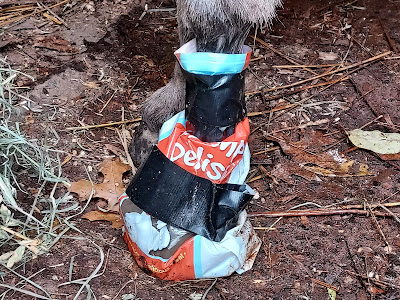OK. I think our dog vet is the best. 99% of the time I think no other vet can compare. We found him back in 2004 in a desperate search to find a vet who would come to the home to euthanize our dog. And we've been using him ever since. (one can only hope he never ever retires)
Other vets who are vivid in my memory are those who were compassionate during euthanasia. That includes my current donkey vet. She attended on that awful day when I had to put Natural (see photo on right) down - my first and ultimately my last horse. And I've been using her for the donks ever since. You've gotta find a vet who understands the differences between horses and donks, and Dr. DeWitt does.
Anyhoo she came out last week to diagnose Gabby's lameness and found an abscess. Here's the official online explanation:
By Brian W. Fitzgerald, DVM
The scenario is all too familiar for many horse owners… yesterday your horse was sound, but today you find him crippled, with no apparent injury! What could have happened? Odds are this horse has a hoof abscess. Sooner or later, nearly all horse owners will encounter this problem. Fortunately, most horses make a full recovery with prompt treatment.
Hoof Abscesses Explained
Hoof abscesses occur when bacteria get trapped between the sensitive laminae (the tissue layer that bonds the hoof capsule to the coffin bone) and the hoof wall or sole. The bacteria create exudate (pus), which builds up and creates pressure behind the hoof wall or sole. This pressure can become extremely painful.
Although most commonly seen during the wet winter and spring months, hoof abscesses can plague horses year-round. Moisture in the environment can soften regions of the foot and make it easier for bacteria to get trapped inside. Extremely dry conditions can cause brittle, cracked feet. The abscess-causing bacteria enter the foot through hoof cracks, by traveling up the white line, though penetrating wounds to the foot, and even by “close” horseshoeing nails.
We are now close to the end of treatment for the little girl, thank goodness. It's involved wrapping special pads around the hoof multiple times and extended soakings. I've gotta tell you, Gorilla tape sticks to anything but is a devil to get off. Dr. DeWitt recommended it as it's thicker than duct tape, so of course I ran to the hardware store to get some. It's pretty fantastic stuff.
A wrapped hoof
 |
Soaking with an improvised bag. We tried using 2 layers of zip lock bags but she busted those open almost immediately. We searching the house for something to use when I said "aha, let's use this chicken treat bag. Worked like a charm. Keep in mind there's a quart of solution in that bag.
The soaking involved two 45-minute sessions so Gabs had to be segregated and occupied with many portions of hay. Although I gave Sugar and Spice equally generous amounts of hay directly in front of the barn to keep Gabby less nervous, Sugar demanded some of the "special" hay.
On Thursday we remove the last of the wraps and hopefully all is well in hoof land.



Oh Poor Gabby. You've done very well indeed in your care for her Nurse Janet. I really hope when the bandages come off all is well with her. Sending her healing vibes from Cheshire. xxx
ReplyDeleteYou're the best!
DeleteI just saw this post. Instead of soaking the hoof we use a product called Animalintex avaiable thru TSC or Amazon. Its a poultice pad that can be used on wounds as well to draw out infection.. You just cut a portion of this pad to fit the hoof and wrap it with Vet
ReplyDeletewrap. You leave it on for about a week. Works great for hoof abcesses. PM if you need to and I can explain more.
Thanks for the tip but I was following the vet's advice.
DeleteI don't know who this is... -- you're shown as anonymous.
Delete